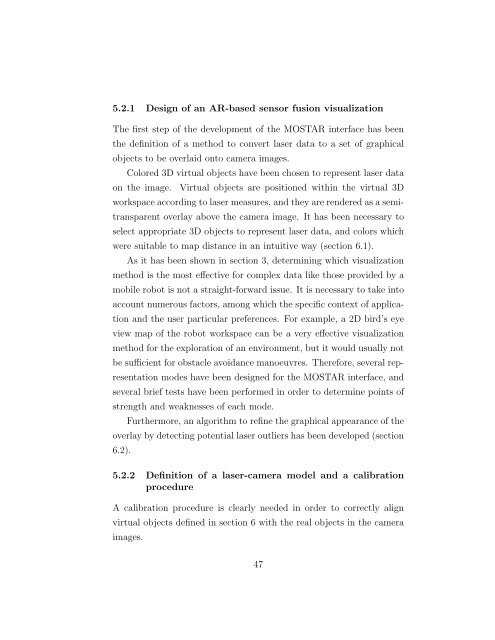Scarica (PDF – 6.19 MB)
Scarica (PDF – 6.19 MB)
Scarica (PDF – 6.19 MB)
You also want an ePaper? Increase the reach of your titles
YUMPU automatically turns print PDFs into web optimized ePapers that Google loves.
5.2.1 Design of an AR-based sensor fusion visualization<br />
The first step of the development of the MOSTAR interface has been<br />
the definition of a method to convert laser data to a set of graphical<br />
objects to be overlaid onto camera images.<br />
Colored 3D virtual objects have been chosen to represent laser data<br />
on the image. Virtual objects are positioned within the virtual 3D<br />
workspace according to laser measures, and they are rendered as a semi-<br />
transparent overlay above the camera image. It has been necessary to<br />
select appropriate 3D objects to represent laser data, and colors which<br />
were suitable to map distance in an intuitive way (section 6.1).<br />
As it has been shown in section 3, determining which visualization<br />
method is the most effective for complex data like those provided by a<br />
mobile robot is not a straight-forward issue. It is necessary to take into<br />
account numerous factors, among which the specific context of applica-<br />
tion and the user particular preferences. For example, a 2D bird’s eye<br />
view map of the robot workspace can be a very effective visualization<br />
method for the exploration of an environment, but it would usually not<br />
be sufficient for obstacle avoidance manoeuvres. Therefore, several rep-<br />
resentation modes have been designed for the MOSTAR interface, and<br />
several brief tests have been performed in order to determine points of<br />
strength and weaknesses of each mode.<br />
Furthermore, an algorithm to refine the graphical appearance of the<br />
overlay by detecting potential laser outliers has been developed (section<br />
6.2).<br />
5.2.2 Definition of a laser-camera model and a calibration<br />
procedure<br />
A calibration procedure is clearly needed in order to correctly align<br />
virtual objects defined in section 6 with the real objects in the camera<br />
images.<br />
47




